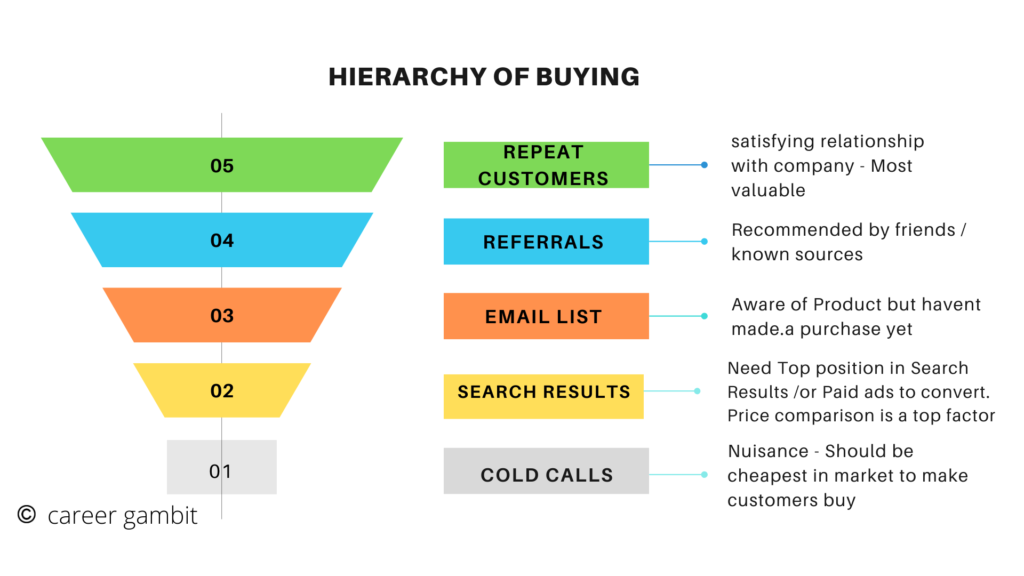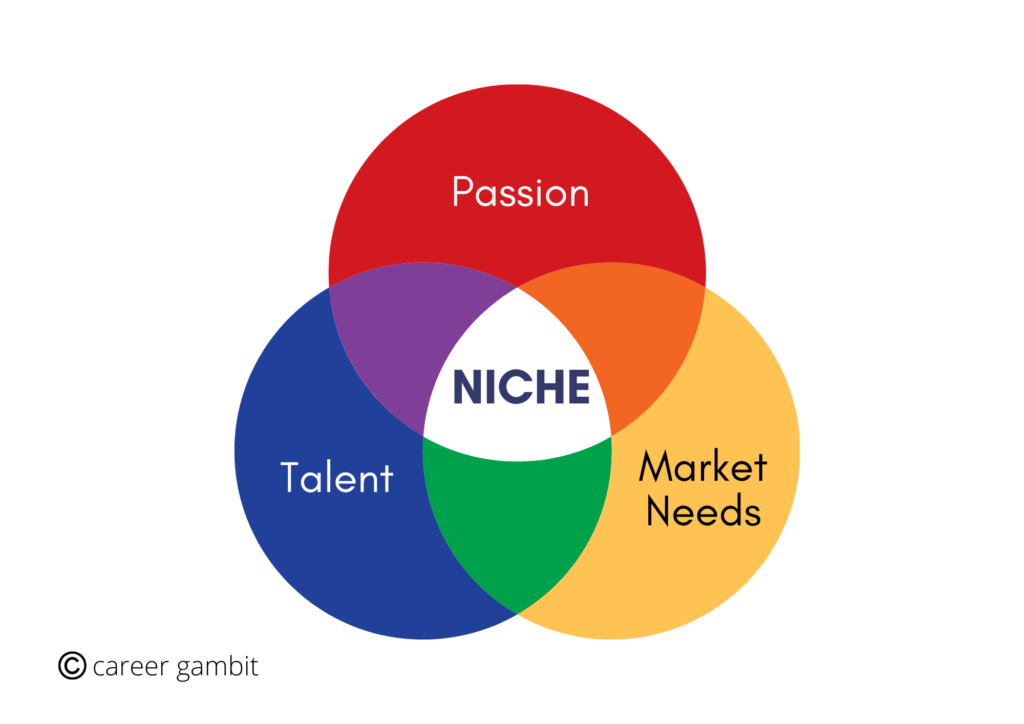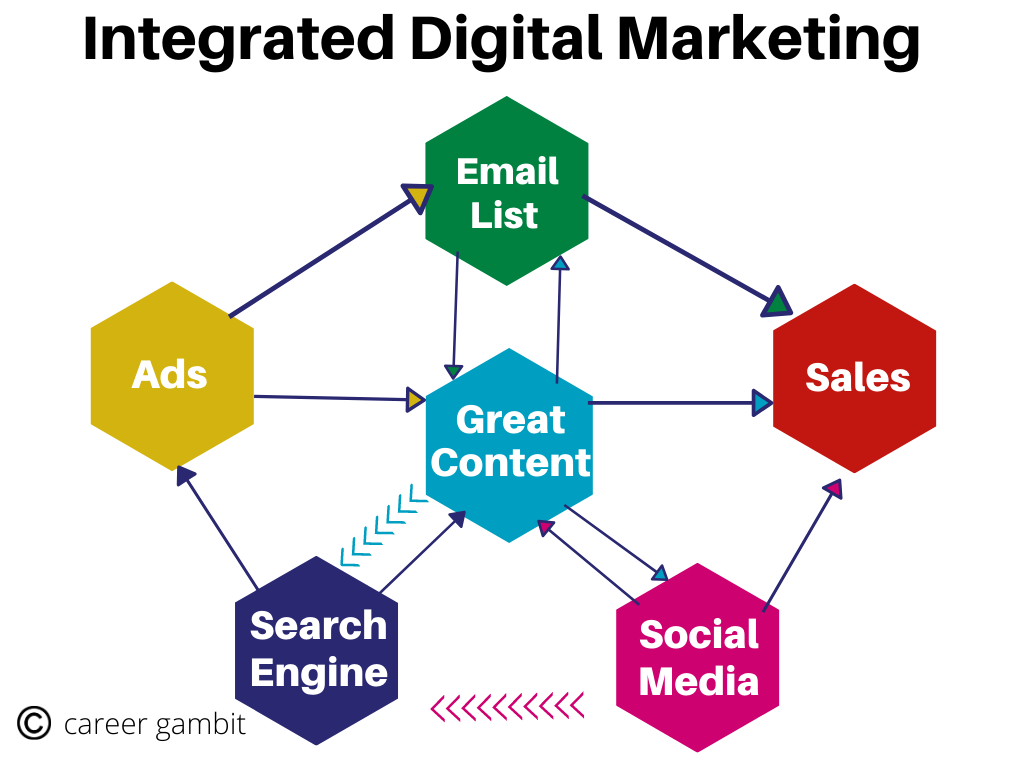
Are you looking for a marketing job?
Chances are when you visit a job portal like naukri.com or attend a job fair or go through the wanted columns in a newspaper you will find there are plenty of marketing jobs available. Most freshers who start a career in marketing don’t have a clear idea about the function of marketing in an organisation.
People cringe at the idea of taking up a marketing role because they are confused by a general misconception for a successful career in marketing, that they have to be pushy and sell something to a person who has no interest in buying the product or service.

The thought that comes to their mind while thinking of a career in marketing is that they have to keep knocking on doors / or make cold calls to get any sales and that it’s a very difficult and tough field to be in.
I am going to break down the basics of marketing and the right way to do it and in the end, you will not only appreciate the need for marketing but have a complete idea of how a marketing strategy should be implemented and how it could be a rewarding career option. So, the next time you are looking at a marketing job ad, you will feel happy about the prospect of working in a field that is perennial and offering great rewards.
What is Marketing?
In simplest terms, marketing is the act of driving profitable customer action by motivating your target audiences to make a purchase.
What does this mean? You are making your audience (the people whose need your product /service is going to fulfill) aware of your product and motivating them to make a purchase to fulfill their requirements. There are a number of strategies/tactics you may use to achieve this goal.
The Fundamentals of Marketing

Understanding the Marketing Mix and the 4 P’s of Marketing: At its core, marketing revolves around four things: product, price, promotion, and place (Source Phillip Kotler — in his book Marketing Management).
Tactics and channels change, but these are the concepts everything else revolves around, and they’re principles that never change.
People buy to fulfil a need or desire and the most valuable customer relationships occur at the top of the buyer’s hierarchy. (Source — Scott Statten in his book UnMarketing)
In order to build something worth buying, you need to identify an underlying human desire or need and make sure your product fulfils it.
Some of the basic needs and desires are safety, respect, adventure, belonging, connection, freedom, strength, tranquility, etc. A product is worth buying only if it satisfies one or more of these aspirations.

Your target audience should share your definition of the desire/need that your product solves and also be open to change. The product you are marketing embodies a certain definition of the need it satisfies and your target audience consists of people who share that need and definition.
The above group can be further divided into Adopters, who are receptive to change and are willing to try a new product or service that comes into the market. Adapters are resistant to change and will stick to the old ways of doing things until they are forced to change. The concept of adopters vs adapters is explained brilliantly in the book “This is Marketing” by Seth Godin.
An example of adopters are those who started using smartphones as soon as they were introduced and the adapters were the last ones to move from flip phones to smartphones as they were forced to change due to wide acceptance of the smartphones and the technology in the devices used by them got outdated.
Adopters are your initial target audience. If there are enough of them to constitute the smallest viable market ( the least number of people to make the product profitable) then you can launch your product. Direct response ads are used for targeting adopters after defining your customer profile in detail.
Network effects provide a powerful way to build a bridge between your initial fanbase and the general public. Your product becomes more valuable as more people use it.
The focus should be on existing customers and ensuring that they get the best experience before and after-sale. The experience gap occurs when there is a difference in how a prospective customer is treated when they are wooed and the experience a customer has from customer support after becoming a customer.
Only when the gap is nil between the two states the customer will become a staunch advocate of your product or services and have a satisfying relationship with your company and be your most valued possession in terms of business and the goodwill in advocating your products to their circle of friends and family.
Misconceptions about marketing
Selling Vs Marketing
Let us step back for a minute and revisit my first premise about people’s misconception about marketing. This comes from a confusion between sales and marketing. They are not the same.
Selling is talking about your product, your offers, your features, your advantages, your benefits, your price, your guarantee, your premium, your bonuses, etc,i.e. when you are talking about yourself (or your product). It is from the company’s perspective.
Marketing is about the prospect. Their situation, their needs, their wants, their desires, their beliefs, their fears, and ultimately the best solution for them right now for the situation they are in. This is from a customer’s perspective.
Sales should be the final activity in a marketing cycle when the customer makes the transaction. Most marketers themselves are confused between the two and create more of a sales campaign than a marketing campaign. This results in the efforts being wasted in a worng direction and causes a lot of frustration to a marketer.
Marketing is about educating your target audience and leading your prospect to the natural conclusion (a transaction) through structured and strategic methods which showcase your product as a solution to their problem. We will see how to lead your prospect and convert them into your customer in a later section about sales funnels.
Traditional marketing Vs Digital marketing
With the advent and popularity of the internet, there is now a new aspect to marketing — Digital Marketing. There is confusion among some marketers on which option to choose.
The below quote of very appropriate response to the digital facet of marketing:
“Everything is changed and nothing is different” Scott Staten in his book UnMarketing.
Internet is a game-changer. It’s the most massive mass medium ever created, connecting billions of people. On the other hand, it’s also the least massive medium. That’s because everyone can curate their own private version of it, with personalised Facebook timeline, Twitter feeds and tailored Youtube suggestions, Spotify playlist, Google news feeds ., etc.
It is an indisputable fact that the internet has revolutionised marketing practices but we should also look at it from the context of the number of potential customers we can reach via the internet.

The total population of India in 2020 is 1,366 million. Out of this, the number of households with TV is predicted to be 200 million in 2020 with a reach of 880 million people (avg number of people per household is 4.4). The number of people with access to the internet is 687.6 million in 2020 with 400 million social media users.
The figures suggest a reach of 50% of the population with internet access and 30% of the population to social media compared to 65% reach in households with Tv.
What are traditional marketing methods?
Billboards, Tv — Newspaper — radio — advertisements, flyers, and posters, etc are the usual traditional marketing methods. They are mainly to create awareness about the product and rely on interruption method to grab our attention and we cannot usually avoid them though we may try to ignore them.
Traditional marketing has the upper hand when it comes to market penetration. The number of people who can be reached by placing an ad on TV or Radio is massive compared to the reach we can achieve with the internet.

Even a social media company like Facebook is using traditional means for advertising via TV and radio ads to reach new audiences from tier 2 / 3 cities and rural areas in India to increase their pool of audience.
Online payments Gpay / Paytm have penetrated all levels of the market by using traditional marketing mediums like TV, newspaper, and radio advertising along with digital marketing. If they had only used digital medium to advertise with the assumption that it is an online (digital) payment method requiring only digital marketing methods, they would not have been successful in penetrating across all the levels of society.
The drawbacks in traditional marketing methods are:
a) a lack of feedback from customers,
b) an inability to measure customer response to a particular mass media ad campaign, and
c) the high cost associated with it.
How has the internet revolutionised marketing?
Though the reach of the internet is less compared to the traditional marketing methods, it also has the people with the maximum spending power. Most products/services are focused on an average person who has a per capita income of more than 9000 $ (or 6 lakhs INR) per annum ; this segment is less than 10% of India’s population. This makes digital marketing a powerful medium to reach the customers with the spending power to buy your products.
In essence, the choice between a traditional or a digital marketing approach should be based upon understanding where your customers are and how to connect with them. Maintaining your communication and relationship with your customer constantly is the backbone of a successful marketing strategy.
Features of Internet advertising
- Precisely target the group of people you want to reach with your message
- Reach customers anytime they log in
- Measure results with precision, so they can be optimised
This also presents a problem
Since every company has access to internet advertising, consumers are overloaded/bombarded with too many ads that they tend to ignore them to an extent.
The solution to this problem is SEO — Search Engine Optimisation – the most relevant content to a customer’s query are displayed at the top of a search engine’s results. In order to appear at the top of the results of a search engine, we need to provide valuable content to the customers.
This ties in with the first definition of marketing where you are educating the customer about your product/service by providing valuable content also tailoring your content to fulfill your target audience’s needs or desires. Creating good quality content that your customers will value is the best way to achieve top rankings in search engines. This leads us back to 2nd step in the buyer’s hierarchy.
How to convert leads generated by SEO into actual sales?
The process to making the customers to move through process which results in a prospect finally becoming your customer is called a sales funnel.
“A conversion (sales) funnel is a continuous mission of getting, keeping and growing your ideal customer base, while using technology, social media, and other available tools to meet their needs more efficiently. It’s lead nurturing, behavioral targeting, retention, and referrals, all rolled into one marketing strategy.”
-Niel Patel, a marketing expert who is also an example of a personal brand in marketing.
CATT Funnel
Content Attention Trust Transactions (CATT ) is one of the funnels for converting your prospect into a customer. This is done by leading prospects through a structured approach called the sales funnel. (Note: further in this article, the CATT funnel will be referred alternately as ‘Sales Funnel’).
The below strategy can be followed, to establish your expertise in your chosen niche. The niche can be identified by matching your talent, passion, and market needs.

Step 1: Create articles (content) on a broad topic. Then zero-in on a specific problem to be solved in that topic (niche).
Step 2: Attention shape sharable viral content to boost publicity. Usually sharable viral content will be:
- Funny, or
- Have a Wow factor, or
- Evoke emotion
Use social media to engage with your customers one conversation at a time using a structured but authentic approach. The primary goal is to get attention by posting engaging content.
Use an appropriate social media platform based on your requirement : Conversational Social platforms: Share updates about interests FB, Twitter, LinkedIn Visual social platforms: Images and video. Insta / Pinterest Dark Social Platforms: Interaction only between users — WhatsApp / Snapchat.

These platforms have a huge customer base but it’s challenging to engage customers here. Adapt your approach by using different methods. For example, using WhatsApp business features to reach customers.
Step 3: Trust — Once you have them in your attention area in the form of a mailing list or contact numbers, you need to build trust with them. It can be done through various techniques like marketing automation or retargeting.
By nuturing the leads which are collected from the above steps, the customers are moved up a step in the buyer’s hierarchy into your email lists.
Trust among people is a very important part of digital marketing. After attracting user attention, you create an atmosphere of trust with your user. You can do this by providing testimonials and showing social proof from existing customers. When people trust you, they automatically come to you.
Step 4: Transaction
One of the best places to create an atmosphere that’s ripe for quick sales is your email list. Compared to a mass email list blast, nurtured emails get 4–10 times the response rate. Transaction step converts lead to customer. The transaction happens in steps 4 and 5 of the buyer’s hierarchy without much effort as a result of the process. Hence the customer does not feel pressured into buying rather it’s a natural conclusion.
Integrated Digital Marketing
An integrated Digital Marketing strategy is always crafting the same experience across all mediums and with every interaction your customer has with your brand.

This can be achieved by unifying every channel that exposes your customer to your brand.
This in turn needs carefully planned tactics with one single goal in mind — directing your customers towards the great content you have created.
By taking this approach, it will ensure that all your channels work together to move your customer further in the Sales Funnel.
The benefits of using an integrated approach are increased Brand awareness, ROI and increased Conversions (which means fewer people are lost in the sales funnel before completing the final transaction), and Brand loyalty.
Personal Branding
Personal branding is the conscious and intentional effort to create and influence public perception of an individual by positioning them as an authority in their industry, elevating their credibility, and differentiating themselves from the competition, to ultimately advance their career, increase their circle of influence, and have a larger impact. (Source — Wikipedia)
You can attract potential customers, by becoming an expert in your field. Offering helpful information will attract your target audience. Ads only attract people who need your product at this very moment. Being an expert will help you reach people who don’t necessarily have an urgent need but are generally interested in your product.
Personal Branding starts with
- learning a new skill,
- working on jobs to get mastery over the skill,
- publishing or creating content (Blogs / Videos) in your skill and become an expert,
- consulting and helping other businesses with your skillset and getting paid for your expertise,
- Mentoring or coaching others to become experts,
- Build your own startup company to monetise the skill set efficiently.

Personal brand influences the perception that the products endorsed by the personal brand will also be associated with the qualities of the personal brand.
For example, when companies use Virat Kohli as a brand ambassador they want to project his success, achievements, and consistent performance towards their own products and create a connection in the public mind between them.
Practical Tip
Having a profile picture instead of a logo in some social media forums helps with engagement as it reinforces that they are interacting with a human instead of a brand.
Conclusion
We have seen various facets of marketing and how to implement marketing strategies. The marketing efforts make or break an organisation’s success. To have a successful career in marketing one should be able to understand and align themselves with the values and needs the product addresses to its customers.
The revenue of a company is directly proportional to the number of customers it serves which in turn is directly proportional to the marketing spend of the company.
So, learning the background on how marketing works will ultimately help you to land your dream marketing job and also have a rewarding career. From a marketing role to CEO of a company is a very real career path. Check out this article from Forbes which provides an interesting read.
From the above article, you would have been able to understand how marketing as a career path can be intellectually stimulating, inspiring, challenging and fulfilling.
Are you now eager to apply for marketing jobs and making it your career choice?
Please share your thoughts and comments below.

Pingback: Upskill With Digital Marketing For Career Growth In 2021: Survey. - Latest Digital Marketing News| Trends|Updates